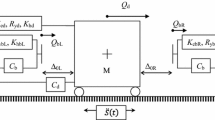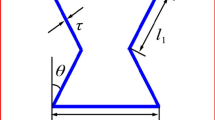Abstract
Origami has recently received wide attention, and the study on its dynamic characteristics remains a nascent field. The waterbomb origami is a common subtype of origami, and its base structure is treated as a bi-stable configuration in the literature. The systematical framework for modeling, simulation and dynamic analysis of the vibration for the waterbomb origami base is established in this paper. In the presented model, the motion of the waterbomb origami base is divided into two working patterns according to its geometric characteristic. The nonlinear governing equation of motion of the waterbomb origami base is formulated based on the Lagrange’s equation. The base’s free and forced responses can be calculated by using the fourth-order Runge–Kutta method. The developed model is validated by the results predicted by the simulation in ADAMS. With the developed theoretical framework, the base’s vertical effective stiffness and natural frequency of its linearized system are discussed to reveal their programmability with respect to the base’s structure and design parameters. Remarkably, the bifurcations of its equilibria, including the pitchfork, transcritical and (special) saddle-node bifurcations, are analyzed. Unlike the bi-stable configuration reported in the literature, the mono- and tri-stable configurations can also be realized by the base due to gravity. Furthermore, the complex nonlinear dynamic behaviors, including chaos, are revealed.


















Similar content being viewed by others
References
Kamrava, S., Mousanezhad, D., Ebrahimi, H., Ghosh, R., Vaziri, A.: Origami-based cellular metamaterial with auxetic, bistable, and self-locking properties. Sci. Rep. 7, 46046 (2017). https://doi.org/10.1038/srep46046
Tao, K., Yi, H., Yang, Y., Chang, H., Wu, J., Tang, L., Yang, Z., Wang, N., Hu, L., Fu, Y., Miao, J., Yuan, W.: Origami-inspired electret-based triboelectric generator for biomechanical and ocean wave energy harvesting. Nano Energy (2020). https://doi.org/10.1016/j.nanoen.2019.104197
Silverberg, J.L., Na, J.H., Evans, A.A., Liu, B., Hull, T.C., Santangelo, C.D., Lang, R.J., Hayward, R.C., Cohen, I.: Origami structures with a critical transition to bistability arising from hidden degrees of freedom. Nat. Mater. 14(4), 389–393 (2015). https://doi.org/10.1038/nmat4232
Castro, C.E., Kilchherr, F., Kim, D.N., Shiao, E.L., Wauer, T., Wortmann, P., Bathe, M., Dietz, H.: A primer to scaffolded DNA origami. Nat. Methods 8(3), 221–229 (2011). https://doi.org/10.1038/nmeth.1570
Schenk, M., Viquerat, A.D., Seffen, K.A., Guest, S.D.: Review of inflatable booms for deployable space structures: packing and rigidization. J. Spacecr. Rockets 51(3), 762–778 (2014). https://doi.org/10.2514/1.A32598
Turner, N., Goodwine, B., Sen, M.: A review of origami applications in mechanical engineering. Proc. Inst. Mech. Eng. C-J. Mech. 230(14), 2345–2362 (2015). https://doi.org/10.1177/0954406215597713
Evans, A.A., Silverberg, J.L., Santangelo, C.D.: Lattice mechanics of origami tessellations. Phys. Rev. E. 92(1), 013205 (2015). https://doi.org/10.1103/PhysRevE.92.013205
Surjadi, J.U., Gao, L., Du, H., Li, X., Xiong, X., Fang, N.X., Lu, Y.: Mechanical metamaterials and their engineering applications. Adv. Eng. Mater. (2019). https://doi.org/10.1002/adem.201800864
Schenk, M., Guest, S.D.: Origami folding: a structural engineering approach. In: Wang-Iverson, P., J. Lang, R., Yim, M. (eds.) Origami 5: Fifth International Meeting of Origami Science, Mathematics, and Education, pp. 291–304. CRC Press, Boca Raton (2011).
Qiu, C., Zhang, K., Dai, J.S.: Repelling-screw based force analysis of origami mechanisms. J. Mech. Robot (2016). https://doi.org/10.1115/1.4031458
Yasuda, H., Miyazawa, Y., Charalampidis, E.G., Chong, C., Kevrekidis, P.G., Yang, J.: Origami-based impact mitigation via rarefaction solitary wave creation. Sci. Adv. 5(5), eaau2835 (2019). https://doi.org/10.1126/sciadv.aau2835
Wei, Z.Y., Guo, Z.V., Dudte, L., Liang, H.Y., Mahadevan, L.: Geometric mechanics of periodic pleated origami. Phys. Rev. Lett. 110(21), 215501 (2013). https://doi.org/10.1103/PhysRevLett.110.215501
Li, S., Fang, H., Sadeghi, S., Bhovad, P., Wang, K.W.: Architected origami materials: how folding creates sophisticated mechanical properties. Adv. Mater. 31(5), e1805282 (2019). https://doi.org/10.1002/adma.201805282
Schenk, M., Guest, S.D.: Geometry of Miura-folded metamaterials. PNAS 110(9), 3276–3281 (2013). https://doi.org/10.1073/pnas.1217998110
Zhang, J., Karagiozova, D., You, Z., Chen, Y., Lu, G.: Quasi-static large deformation compressive behaviour of origami-based metamaterials. Int. J. Mech. Sci. 153, 194–207 (2019). https://doi.org/10.1016/j.ijmecsci.2019.01.044
Zhai, Z., Wang, Y., Jiang, H.: Origami-inspired, on-demand deployable and collapsible mechanical metamaterials with tunable stiffness. PNAS 115(9), 2032–2037 (2018). https://doi.org/10.1073/pnas.1720171115
Mukhopadhyay, T., Ma, J., Feng, H., Hou, D., Gattas, J.M., Chen, Y., You, Z.: Programmable stiffness and shape modulation in origami materials: emergence of a distant actuation feature. Appl. Mater. Today (2020). https://doi.org/10.1016/j.apmt.2019.100537
Geradin, M., Rixen, D.J.: Mechanical Vibrations: Theory and Application to Structural Dynamics. Wiley, New York (2014)
Ishida, S., Suzuki, K., Shimosaka, H.: Design and experimental analysis of origami-inspired vibration isolator with quasi-zero-stiffness characteristic. J. Vib. Acoust. (2017). https://doi.org/10.1115/1.4036465
Ishida, S., Uchida, H., Shimosaka, H., Hagiwara, I.: Design and numerical analysis of vibration isolators with quasi-zero-stiffness characteristics using bistable foldable structures. J. Vib. Acoust. (2017). https://doi.org/10.1115/1.4036096
Fang, H., Li, S., Ji, H., Wang, K.W.: Dynamics of a bistable Miura-origami structure. Phys. Rev. E 95(5–1), 052211 (2017). https://doi.org/10.1103/PhysRevE.95.052211
Sadeghi, S., Li, S.: Fluidic origami cellular structure with asymmetric quasi-zero stiffness for low-frequency vibration isolation. Smart Mater. Struct. (2019). https://doi.org/10.1088/1361-665X/ab143c
Rodrigues, G.V., Fonseca, L.M., Savi, M.A., Paiva, A.: Nonlinear dynamics of an adaptive origami-stent system. Int. J. Mech. Sci. 133, 303–318 (2017). https://doi.org/10.1016/j.ijmecsci.2017.08.050
Lee, D.Y., Kim, J.S., Kim, S.R., Koh, J.S., Cho, K.J.: The deformable wheel robot using magic-ball origami structure. In: ASME 2013 International Design Engineering Technical Conferences and Computers and Information in Engineering Conference (2013), p. V06BT07A040
Brunck, V., Lechenault, F., Reid, A., Adda-Bedia, M.: Elastic theory of origami-based metamaterials. Phys. Rev. E. 93(3), 033005 (2016). https://doi.org/10.1103/PhysRevE.93.033005
Rus, D., Tolley, M.T.: Design, fabrication and control of origami robots. Nat. Rev. Mater. 3(6), 101–112 (2018). https://doi.org/10.1038/s41578-018-0009-8
Kuder, I.K., Arrieta, A.F., Raither, W.E., Ermanni, P.: Variable stiffness material and structural concepts for morphing applications. Prog. Aerosp. Sci. 63, 33–55 (2013). https://doi.org/10.1016/j.paerosci.2013.07.001
Hanna, B.H., Magleby, S.P., Lang, R.J., Howell, L.L.: Force-deflection modeling for generalized origami waterbomb-base mechanisms. J. Appl. Mech. (2015). https://doi.org/10.1115/1.4030659
Hanna, B.H., Lund, J.M., Lang, R.J., Magleby, S.P., Howell, L.L.: Waterbomb base: a symmetric single-vertex bistable origami mechanism. Smart Mater. Struct. (2014). https://doi.org/10.1088/0964-1726/23/9/094009
Bowen, L., Springsteen, K., Feldstein, H., Frecker, M., Simpson, T.W., von Lockette, P.: Development and validation of a dynamic model of magneto-active elastomer actuation of the origami waterbomb base. J. Mech. Robot (2015). https://doi.org/10.1115/1.4029290
Sadeghi, S., Li, S.: Analyzing the bi-directional dynamic morphing of a bi-stable water-bomb base origami. In: Proceedings Volume 10968 of SPIE Smart Structures + Nondestructive Evaluation, 109680S (2019). https://doi.org/10.1117/12.2512301
You, Z.: Materials design. Folding structures out of flat materials. Science 345(6197), 623–624 (2014). https://doi.org/10.1126/science.1257841
Arrieta, A.F., Hagedorn, P., Erturk, A., Inman, D.J.: A piezoelectric bistable plate for nonlinear broadband energy harvesting. Appl. Phys. Lett. (2010). https://doi.org/10.1063/1.3487780
Lu, Z., Brennan, M.J., Chen, L.-Q.: On the transmissibilities of nonlinear vibration isolation system. J. Sound Vibr. 375, 28–37 (2016). https://doi.org/10.1016/j.jsv.2016.04.032
Han, H., Cao, D., Liu, L.: A new approach for steady-state dynamic response of axially functionally graded and non-uniformed beams. Compos. Struct. (2019). https://doi.org/10.1016/j.compstruct.2019.111270
Liu, J., Ou, H., Zeng, R., Zhou, J., Long, K., Wen, G., Xie, Y.M.: Fabrication, dynamic properties and multi-objective optimization of a metal origami tube with Miura sheets. Thin Wall. Struct. (2019). https://doi.org/10.1016/j.tws.2019.106352
Chen, X., Zhang, X., Lu, Y., Li, Y.: Static and dynamic analysis of the postbuckling of bi-directional functionally graded material microbeams. Int. J. Mech. Sci. 151, 424–443 (2019). https://doi.org/10.1016/j.ijmecsci.2018.12.001
Gottwald, G.A., Melbourne, I.: On the implementation of the 0–1 test for chaos. SIAM J. Appl. Dyn. Syst. 8(1), 129–145 (2009). https://doi.org/10.1137/080718851
Acknowledgements
The authors are grateful for the financial support from China Scholarship Council (No. 201906120086) and National Natural Science Foundation of China (Grant Nos. 11732005 and 11902184).
Author information
Authors and Affiliations
Corresponding authors
Ethics declarations
Conflict of interest
The authors declare that they have no conflict of interest.
Additional information
Publisher's Note
Springer Nature remains neutral with regard to jurisdictional claims in published maps and institutional affiliations.
Appendices
Appendix A
The first derivative expressions of \(\gamma\) which is given by Eq. (1) with respect to \(\theta\) are
where
Its second derivative expressions can be given by
where
The expressions of \(T_{1}\), \(T_{2}\) and \(T_{3}\) in Eq. (18) are
while their derivatives with respect to \(\theta\) can be expressed as
Appendix B
The dimensionless time history, spectrogram, phase space and Poincare section corresponding to Figs. 14 and 17 are shown as follows (Figs. 19, 20).
Dimensionless time history, spectrogram, phase space and Poincare section (red point) of the response of the WOB under the excitation at different \(\overline{\omega }_{{ f}}\). System parameters are the same as those in Sect. 3.6. (Color figure online)
Dimensionless time history, spectrogram, phase space and Poincare section (red point) of the response of the WOB at \(\overline{\omega }_{{ f}} = 1\) with different \(\overline{k}\). System parameters are the same as those in Sect. 3.6. (Color figure online)
Rights and permissions
About this article
Cite this article
Han, H., Tang, L., Cao, D. et al. Modeling and analysis of dynamic characteristics of multi-stable waterbomb origami base. Nonlinear Dyn 102, 2339–2362 (2020). https://doi.org/10.1007/s11071-020-06082-8
Received:
Accepted:
Published:
Issue Date:
DOI: https://doi.org/10.1007/s11071-020-06082-8







